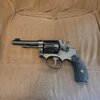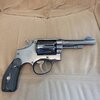Howdy
Something does not compute.
There is no such thing as a 1903 S&W Hand Ejector.
If we are talking about 32-20, it has to be either the 32-20 Hand Ejector 1st Model, which was made from 1899 until 1902, the 32-20 Hand Ejector Model 1902 (32-20 Hand Ejector 2nd Model) made from 1902 until 1905, 32-20 Hand Ejector Model of 1902 1st Change made from 1903 until 1905, or the 32-20 Model of 1905, 1st Change, 2nd Change, 3rd Change, or 4th Change.
The 32-20 cartridge is too long for an I frame revolver, so no I frames were ever chambered for 32-20.
The 32-20 Hand Ejectors were pretty much identical to the 38 Military and Police series of revolvers. Built on the same size K frame, only chambered for 32-20 instead of 38 Special.
This 32-20 Hand Ejector 4th Change shipped in 1916. The 1905 4th Change (changes simply denotes minor mechanical changes not worthy of a newer model designation) was the most produced of both the 38 M&P and the 32-20 Hand Ejectors, produced from 1905 to 1940. 78,983 32 Hand Ejectors Model of 1905 4th Change were produced from 1915 until 1940.


The suggestion to check the Standard Catalog of Smith and Wesson for the manufacturing date of the serial number may or may not be helpful. There were so many 4th Changes made that the SCSW does not specify years for that model, only a very broad range of serial numbers produced from 1915 to 1940.
If the photo you posted is of the revolver, it is not a 1st Model, because that model lacked a lug under the barrel to fasten the front of the extractor rod.
I do not have a list of patent dates handy, but I suspect the revolver in question is not a 32-20 1st Model, or a Model of 1902 because they stopped being manufactured in 1905 and I suspect they would not have a 1906 patent date on them.
This is good, because the 1st Model, and the two models of 1902 had a different mechanism and parts would be very difficult to find.
I am familiar with the 32-20/WCF. From what i read last night, how it is stamped determines the year range it was made.
Not really. Although the style of the marking varied over the years, that is not a very reliable way to determine when a Smith and Wesson revolver was made.
Any way you can post the Serial Number so we can get to the bottom of this? The Serial Number will be stamped onto the bottom of the butt. If you do not want to post the entire Serial Number, you can substitute Xs for the last two digits, but make sure you have the correct number of digits.
These revolvers were designed to shoot Smokeless ammunition. I would not bother shooting ammunition loaded with Black Powder in one. I shoot Black Powder cartridges all the time in antique revolvers, but the tolerances on a S&W Hand Ejector made from 1905 on are pretty tight, and it will bind up quite rapidly with Black Powder ammunition.
















